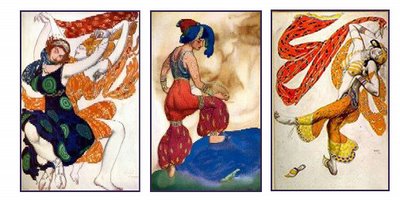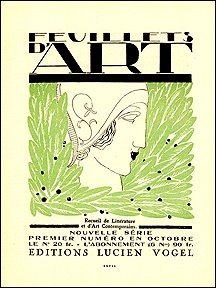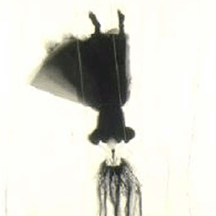The company's first choreographer, Michel Fokine, brought an expressive and more natural style to the staid technique-obsessed world of ballet, which was loosing audiences who were more excited by the "free dance" movement that broke free of the rigid formalism of ballet.
Click here for a brief explanation of "free dance," "modern dance" and its connection to dancers at the Folies Bergere.
In its first season it performed Cleopatra -- one of the "oriental operas" but it was its second season’s performance of Scherzerezhade that particularly captured the imagination of the public. As important as the dance and music was the impact of the set and costume designs done by the Russian Artist Leon Bakst.
 The exotic themed ballets of the Ballet Russe and Leon Bakst's vivid and innovative costumes sparked a fascination with fashion inspired by the Middle East--or, their fantasies of the East.
The exotic themed ballets of the Ballet Russe and Leon Bakst's vivid and innovative costumes sparked a fascination with fashion inspired by the Middle East--or, their fantasies of the East.Click here for a brief introduction to the concept of "orientalism."
It is significant that this fashion inspiration came from the ballet because, as I discussed earlier, the designers were creating clothing for a "new woman" who was energetic, active and--often dancing herself. These costumes were designed to allow the body to move and to emphasize its movements.
Europeans were captivated by art and design that evoked notions of the "folk" or "primitive" or "exotic." During the 1880s and 1890s with the Art Nouveau style explored these themes and continued into the 1920s with Art Deco, which incorporated ideas from the early avant-garde movements such as Cubism. The Ballet Russe was an essential part of this phenomenon and was a significant link between these two aesthetics movements, which can all be seen as facets of La Belle Époque!
Perhaps nowhere were these connections more evident than in the world of fashion and, especially in the designs by Paul Poiret. Poiret opened his salon in 1903 and was experimenting with Eastern-influences fabrics and styles before the arrival of the Ballet Russe in 1909. Yet the combination of the two produced a fashion phenomenon.
Click here for a brief introduction to some of the fashion designs of Paul Poiret.
Resources
Diaghilev's Ballets Russes -- biographies, ballet descriptions and a chronology of all of their performances in Paris
Ballet Russe and the Dance Revolution
An online exhibit on Ballet Russe costumes
More Leon Bakst costume designs
Russian Orientalism and the Ballet Russe by Laurel Victoria Gray (article)



No comments:
Post a Comment